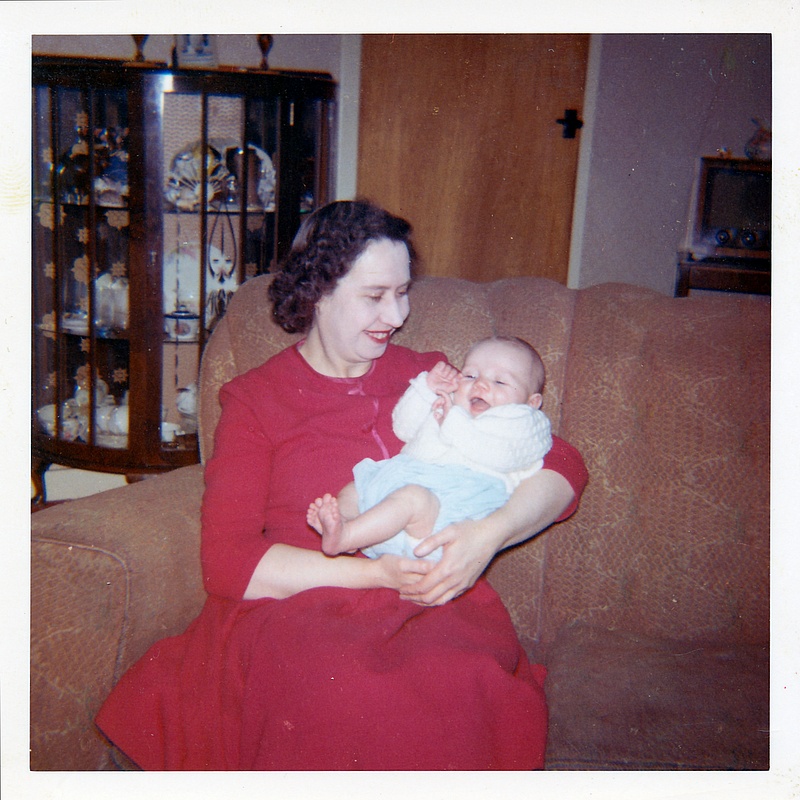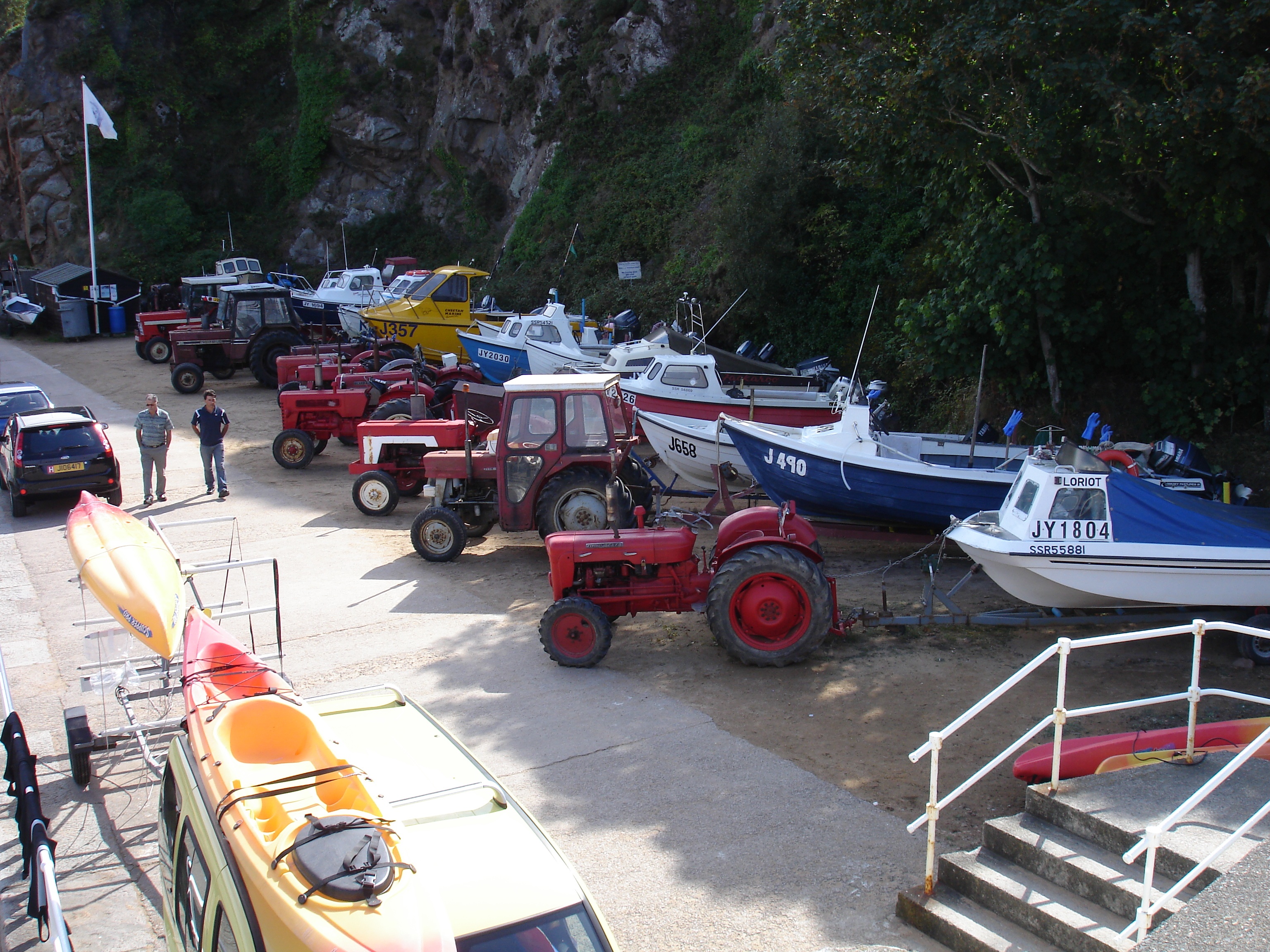Originally posted 3 Jun 2010 [ updated 25 September 2020 ] 
Following on from my comparison of Digital vs 35mm Film, I was inspired to find out how consumer-level photography looked just prior to the wide adoption of the 35mm format. The thing that interested me about this subject was thinking back to early family photographs in old albums - they were a lot smaller in those days ! I think this had a lot to do with the prohibitive cost of colour film processing back then. By the time I got interested in photography in the late 70s, it was pretty mainstream, but relatively much more expensive than today. However, looking through old pre-35mm photos from my parents' time, it is clear that many of the prints were not much bigger than the original negatives. For example, the photo below of me as a baby with my Auntie Sadie is roughly 8 x 8 cm. Note that this photo is just slightly younger than the camera shown at top left. 
So I wondered; just how did the cheaper end of the consumer photographic equipment compare with today's point-and-shoot digital gear ? With this in mind, I went on ebay and purchased a cheap 120 roll film camera (an Agfa Isola). I ran a film through it and ordered a photoCD when I had it processed. You can see the images I produced in my Flickr set, but I've also included two below. Note that you can see any of these images full size by right-clicking on them and selecting 'Open image in a new tab'. Regressing to this form of photography was not without its problems, in particular :- It is really easy to forget to adjust the focus before taking a photo - I messed up a couple of images like that ! I was concerned about the small red frame counter window on the camera back so I used a piece of black masking tape to cover it while I was not actually winding the film on. This may have been unnecessary but I think these clear red windows were only any good at preventing black & white film from becoming fogged - any red light getting through could reflect around the insides and easily fog a colour film. Overall, I was quite impressed with the performance. Image quality was roughly on a par with digital cameras from just a couple of years back (at the time of writing). The modern machine processing and scanning produced better colours and detail than you would typically see on old prints. .jpg) .jpg) 35mm SLRs became affordable in the 70s, and digicams made it onto the scene around the turn of the century. If you were an enthusiast, there were always higher quality options available but most people used inexpensive gear costing £20-50. My Fujica ST705W was "reduced to clear" at £79 -a real bargain in 1979 when a typical 35mm SLR cost £100-£150. All other things being equal, the drop from medium format to 35mm must have resulted in a lowering of image quality. However, lenses improved during this same period, and other enhancements such as automatic exposure, wider availability of rangefinders and eventually autofocusing, compensated quite a bit. There was a dubious flirtation with even smaller film formats such as 110 that led to considerable decrease in image quality. Have a look at this 1976 snapshot of Venice :- 
If you right-click and open the photo above in a new tab, the film grain will be immediately apparent - terrible quality from the 10mm wide negatives. 110 cameras looked stylish and the film came in an attractive cartridge format that was simple to load. The larger 126 film format used a similar cartridge but had a 26mm wide film that potentially could have produced similar quality to 35mm. Unfortunately the emphasis in the 70s was on convenience and there were hardly any good quality 126 cameras made (eg. Minolta Autopak 700/800, OlympusQuickmatic, Ricoh 126C). They quickly gave way to compact 110 models costing from £20. (Average earnings in 1975 were about £72/week so this was about 28% of a weekly wage) As disposable incomes increased, 35mm rangefinder cameras became popular. These were significantly more expensive than 110 and 126 models but generally had good lenses and coould produce pretty good images. Many had rangefinder focusing and auto exposure. There was a further attempt at bringing together a larger negative size with simple loading in the APS format. This cartridge was very innovative and the format provided a degree of smartness with regard to filmspeeds. APS cameras could even shoot different image sizes and aspect ratios on the same film. All of these ideas were swept aside by the rush towards digital photography at the turn of the century. So how did those early digital cameras compare ? Here is a holiday snap from 2001 taken on a Kodak DC215 Zoom (bought in 2000) :-  As you might have guessed these early digicams had very poor image quality - nowhere near that of the Isola, which by this time would have been a 40 year old camera. Of course, electronics advance very quickly. Things were much improved two years later in 2002 when 3 megapixel zoom models with proper autofocus were mainstream. Here's a snap from a Minolta DiMAGE S304 :- 
As you can see, the focus is much better and combined with the increased depth-of-field, the image sharpness is much closer to what we expect today. By 2006, digicams were typically 6-8 megapixels. Here is an image from a 7mp Sony DSC-W7 in 2006 :-  With a few more refinements such as antishake, face detection, and some more megapixels (at the expense of noise), these cameras evolved into the slick consumer cameras we know today. It was easy to pick up something capable of producing presentable 30" x 20" enlargements for around £100 in 2010. (A medium range model costing £200 would represent 28% of the 2010 weekly average wage of £722, and provide a good direct comparison with the 110 camera of 1975 costing £20. However, allowing for the increasing gap between typical wage and the "average", a £100 digicam at 2010 prices is probably a more realistic equivalent) It's interesting to note that the potential quality of entry level consumer cameras initially went down from 1960 with the increasing adoption of 35mm films, and even smaller formats such as the 110 cartridges. Picture quality fell again when the first digicams were produced, and only really improved above the 1960 level with the 2nd and 3rd generation models around 2003/2004. The Agfa Isola is just one example of a modest camera that performed fairly well. No doubt there are quite a few other low-cost medium format cameras from that time with better lenses that would have taken sharper pictures. Of course throughout this time there have always been better quality models at enthusiast and professional level, but it's interesting to see how the cheap end performed. I think it's fairly clear from this comparison that it took over 40 years to get back to the same quality that your average snapper might have enjoyed in 1960 - if they could afford the processing ! 2020: Nowadays smartphones with their sophisticated built-in cameras have all but wiped out the compact digital camera market. Some of the top-end smartphones are even competitive with the prosumer end of the dedicated camera market. Who knows what the future will bring? |